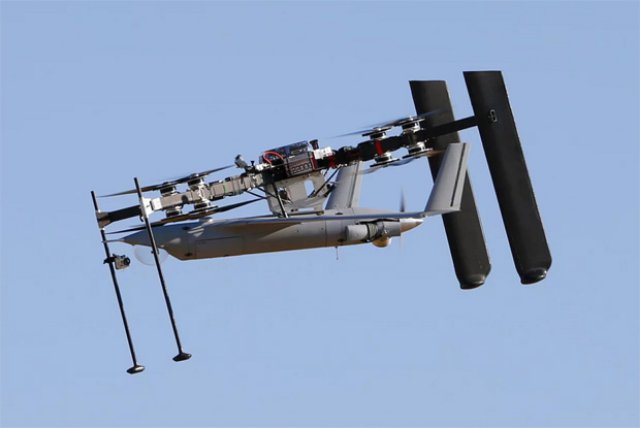 Insitu, the makers of the ScanEagle, last week debuted a new launching system that uses a quadcopter to carry the plane-shaped ScanEagle into the sky and release it into takeoff. Later, when the Eagle is done flying, the quad-copter catches it in mid-air and returns to the ground.
Insitu, the makers of the ScanEagle, last week debuted a new launching system that uses a quadcopter to carry the plane-shaped ScanEagle into the sky and release it into takeoff. Later, when the Eagle is done flying, the quad-copter catches it in mid-air and returns to the ground.
Normally, a ScanEagle takes off from a metal rail, and then returns by flying into a powerful hook that snags it out of the sky. It’s adapted from a drone made for fishermen, and there’s not a lot of room on a ship for runways or landings.
The new system is called FLARES, for “Flying Launch and Recovery System”. It replaces the hook and rail system by combining them into one single platforms that launches the ScanEagle and catches it in flight. In two drones, it solves one of the major problems that has vexed all levels of aviation: a body built for vertical takeoff isn’t the best body for distance flight, and a fixed-wing body built for efficiently flying needs a runway to work. Google’s own delivery drone attempted to fly level and take off like a copter, but they, like many others before, them abandoned the idea as unwieldy.
The launch is mostly self-explanatory: the ScanEagle gets hauled up a few hundred feet, throttles up, and drops, quickly achieving enough lift for horizontal flight. The catch is a bit trickier: the octocopter is attached to an anchor on the ground with a long cable that it carries up into the air, acting as a sort of sky-anchor. The ScanEagle drone navigates to the cable and flies into it, catching it in a little hook at the tip of one of its wings.
Insitu tells us that pulleys on the ground anchor release tension on the cable, “letting it unwind, like a fishing reel.” This allows the cable to absorb some of the drone’s energy (although you can hear the octocopter’s engines revving up a little bit). Finally, the cable is reeled in, and both drones are recovered. It’s pretty incredible to watch on video, but according to Andrew Hayes, Director of Advanced Development for Insitu, it’s way better in person:
“There’s a tremendous amount of power in the system—the vehicle almost leaps off the ground at takeoff. It’s surprising to watch. Also, the vehicle is completely rock solid in the air throughout capture—meaning it doesn’t move at all when ScanEagle hits the line. It’s like someone bolted it into the sky.”
This version of FLARES was built primarily with commercial off-the-shelf parts. At this point, it’s mostly autonomous, although Insitu is working on making the system even more flexible, with the capability of (among other things) operating on ships. They’re also working on increasing the launch weight, which probably means a ScanEagle with a heavier payload.
Sources: Spectrum IEEE; PopSci
